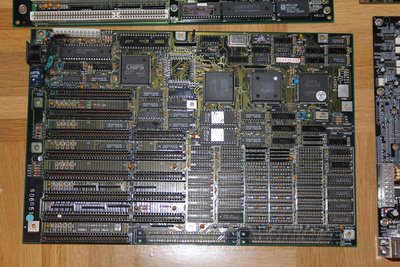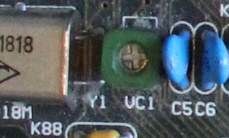Hi!
I’d say you have a really good chance at getting that board working well again. It looks like the battery corroded the 12V trace to the point where resistive heating burnt the PCB and may have also set off the orange tantalum capacitor near the AT power connector. The corrosion from the battery does not look too bad compared to boards that have successfully been repaired.
Your board is most likely a 4 layer board as follows:
L1 = signal traces (top)
L2 = ground plane
L3 = +5V plane
L4 = signal traces (bottom)
I think you’re assumptions are right. The fuse connects the internal 5V plane to the keyboard and the only sensible traces on the top layer that are completely missing are the +12 and -12 rails. The unpopulated component L4 and it’s partner should connect to the keyboard plug, just check the continuity there as you may need to rework that trace too.
If you’re really keen on getting this board going, I’d say you could:
1. Clean the affected area with vinegar until you’re certain the potassium hydroxide is neutralized. I do this under hot running water with a soft paintbrush to apply and clean the affected areas. When it looks like its clean, I just fully submerse the board and rinse it a few times for in cold water before quickly drying it with warm air. Don't let the board sit wet for too long as any missed areas will corrode really quickly. Make sure you do this with gloves on and away from anywhere close to food. You should always wear gloves anyway, everything on those corroded boards will leech into your skin.
From your cleaned up pictures, you still have a lot of areas that appear to need cleaning that will continue to corrode. It’s up to you to decide if you want to replace the ICs and the RTC trimmer cap but you should really try and halt the corrosion up the 12 rail and inside the ISA slots. It looks like the electrolyte has wicked under the solder mask and will continue to slowly cause issues. Ideally you could remove the ISA slots that cover the really bad areas and re-tin that track.
2. Replace the 12V rails with hookup wire, and using 30 gauge wire-wrap fix any corroded vias. With a lot of flux and a bit of old solder-wick, you can gently remove the damaged mask and re-tin the corroded areas.
3. Replace the CPU socket and missing DRAM. You probably don't need to replace the capacitors for testing.
4. If it’s working, reseal the exposed copper areas with some acrylic conformal coating. It comes in a nail-polish bottle and can be removed if more rework is required.
Always a bit annoying seeing an unused external battery connector 😀 Fingers crossed, looks like a great board.




